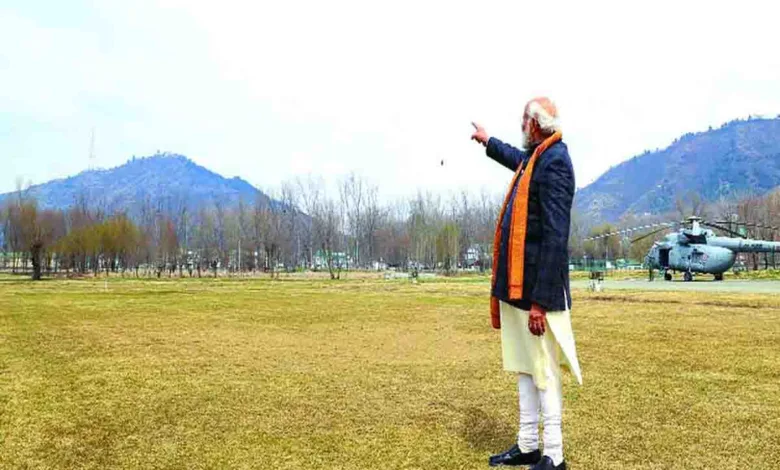Kashmir’s moving trajectory: From Nehru’s heart to Modi’s crown

VIEWPOINT
 Romit Bagchi
Romit Bagchi
Now when the Kashmir valley is in a state of churn after Prime Minister Narendra Modi’s ‘crown of India’ speech in Srinagar, a flurry of questions is swirling in the mind begging for answers. One of them is: why did then Prime Minister Jawaharlal Nehru stop the army operation suddenly when the Indian army was close to beating out the tribal invaders from the whole of the Kashmir territory? Though this is a much-discussed and debated matter with every layer of it having been subjected to hair-splitting analysis for years, something of it still remains elusive, prompting revisits.
But before delving into this, let us recall that then Deputy Prime Minister and the Minister of States Sardar Vallabbhai Patel was not enthusiastic to take Kashmir into India. He would say he would not be unhappy if the Maharaja Hari Singh chose accession into Pakistan. As a matter of fact, he was more obsessed with Junagadh and Hyderabad than with Kashmir. Junagadh and Hyderabad were ruled by Muslim rulers while the people there were mostly Hindus. He thought that in case the rulers opted for Pakistan or chose to retain independence, they might become ‘Trojan Horses’ within the Indian mainland to be used by hostile Pakistan to destabilise India. His lack of active interest with Kashmir’s accession stemmed from his belief that the accession of the Muslim majority region might set off endless turmoil because of its geographical contiguity to Pakistan. But Nehru was emotionally attached to Kashmir on two counts-first, he was a native Kashmiri and second, his deep bonding with Sheikh Mohammad Abdullah, the undisputed leader of the Kashmir valley adoringly called ‘Sher- e –Kashmir’.
When Hari Singh was dithering on whether to retain independence or accede to India, a large group of organised tribesmen unleashed by Pakistan swarmed into Kashmir on the night of October 24, 1947 and marched unstoppably towards Srinagar, leaving a gory trail of death, abduction and plunder in their wake and prompting then Prime Minister of the embattled princely State Mehr Chand Mahajan to air-dash to Delhi with an appeal of the king to the Indian Government to send its troops to the valley immediately. With the accession process completed, the Indian troops were flown to Srinagar three days later.
Between October 27 and November 8, 1947, the military reinforcements of India forced the invaders into retreating and marched triumphantly into Baramulla via Srinagar. It was then that the Indian army was stopped from recovering the Muzaffarabad belt and the Gilgit Agency now known as Pakistan-occupied Kashmir or Azad Kashmir.
Journalist Kuldip Nayar while interviewing Major General Kulwant Singh, who had been tasked with pushing back the infiltrators, asked him why he had stopped the Indian army from recovering these territories which then looked like a cakewalk for them. Singh’s reply was significant. He had been told by Nehru to halt the Indian Army’s advance at a place where the Kashmiri language was no longer spoken.
The Nehruvians argue that it was a pragmatic decision born out of a farsighted calculation honed by Nehru’s discerning knowledge of his native place. The writ of Sheikh Abdullah, who was appointed the emergency administrator after the princely State’s accession to India at the instance of Nehru, extended only to the Kashmiri-speaking areas. To impart a democratic veneer to the accession of the Muslim majority Kashmir into the Hindu majority India, Nehru had already resolved to go for a partial plebiscite, keeping the non-Kashmiri speaking areas out of its purview, basing on Sheikh Abdullah’s popular sway on the people of the Kashmir valley. He stood vindicated after Sheikh Abdullah’s National Conference swept the Kashmir’s Constituent Assembly election of 1948 following which he was elected the first Prime Minister of Jammu and Kashmir. However, then Pakistan Premier Liaquat Ali Khan rejected this partial plebiscite stratagem of India and insisted it must cover the whole State.
In step with its strategy to combat Pakistan by fortifying accession through gaining international goodwill, the Nehru government took the matter to the United Nations on January 1, 1948. Intervening officially for the first time, the Security Council passed its three-part resolution on August 13, 1948: calling for a complete ceasefire, asking Pakistan to withdraw all its forces regular or irregular from the entire territory of Jammu and Kashmir; acceptance of India’s right to retain part of its troops in Kashmir and recommending a plebiscite, asserting that the future status of Jammu and Kashmir would be determined only in accordance with the will of its people.
Interestingly enough, with the pragmatic Nehru veiling the idealistic Nehru, the government allowed the army to carry on with its operations in dangerously volatile Kashmir till the end of November 1948, disregarding the UN’s ceasefire diktat. It stopped the operation only after the Indian army had captured some strategic points, including Kargil, to secure the route to Buddhist Ladakh and safeguard the Hindu and Sikh majority town of Poonch.
A section of the military experts ascribes Indian army’s easy success in beating the raiders out of the Kashmir valley to the people’s unswerving support to it, given their loyalty to Sheikh Abdullah and the atrocities the invaders had let loose on them. According to them, the army was most likely to face stiff resistance from the hostile people beyond the valley and it would have instantaneously changed the character of the Indian army from liberator to conqueror to the detriment of India’s long-term interests. A journalist who covered the Kashmir operations, Balraj Puri writes: “The military and political cost of attempting to conquer the area from Mirpur to Gilgit and Baltistan and retain it within India would have been prohibitive for India at that stage, apart from the fact that it would have lost us much international goodwill.”
So, in hindsight, it may seem that the Nehru government’s strategy and actions on Kashmir were not wrong. Moreover, it was a testing time for the government when a large section of the people was staring down at starvation and the collective psyche of the nation was still smarting under the traumatic experiences of pre- and post-Partition cataclysm.
And yet, all said and done, we cannot dismiss the stance of Nehru’s critics on the Kashmir ‘muddle’ as impractical and inimical to the interests of the country. They might be right too in their thinking that had Nehru shown guts to take the bull by the horns without allowing himself and the country to get ensnared in the Cold War-spawned international intrigues, things might have turned in India’s favour in due course of time. However, it is futile now to indulge in what could have happened speculations. It is at risk of being reduced to smear exercise, far from edifying.
What is important is that things have now undergone a sea change, thus spurring a resuscitated India to take things resolutely to their culmination. And this is what the Narendra Modi government has been doing with an unshakable poise of self-assurance under a well-thought-out Kashmir strategy.






